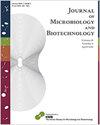Whole-Genome Sequencing of Three Lactiplantibacillus plantarum Strains Reveals Potential Metabolites for Boosting Host Immunity Safely.
IF 2.5
4区 生物学
Q3 BIOTECHNOLOGY & APPLIED MICROBIOLOGY
引用次数: 0
Abstract
In response to the growing demand for immune-related products, this study evaluated the safety and immune-modulating potential of three newly discovered Lactiplantibacillus plantarum strains (GKM3, GKK1, and GKD7) through toxicity tests and whole-genome sequencing. Safety evaluations, including the analysis of antimicrobial resistance genes, virulence factors, plasmids, and prophages, classified these strains as safe for human consumption. Acute oral toxicity tests further supported their safety. To evaluate their immune-modulating potential, dendritic cells were exposed to these strains, and the secretion of key cytokines (IFN-β and IL-12) was measured. Among the strains, GKK1 exhibited the highest enhancement of IFN-β and IL-12 production, suggesting its potential as an immune-stimulating probiotic. Bioinformatics analysis revealed potential metabolic pathways and secondary metabolites, including predicted bacteriocins, associated with immune modulation. The presence of a nitrate reductase region in the GKK1 strain indicated its ability to produce nitric oxide, a critical molecule involved in immune regulation and host defense. The presence of glucorhamnanrelated gene clusters in GKK1 also suggested immune-enhancing effects. Nitrate reductase expression was confirmed using qPCR, with the highest levels detected in GKK1. Moreover, this study is the first to show an anti-inflammatory effect of plantaricin A, linked to its presence in strain GKM3 and its potential therapeutic applications due to sequence similarity to known antiinflammatory peptides. Overall, these three L. plantarum strains demonstrated a safe profile and GKK1 showed potential as an immunity-enhancing probiotic. However, additional investigation is required to confirm the involvement of specific metabolic pathways, secondary metabolites, and bacteriocins in immune responses.三个植物乳杆菌菌株的全基因组测序揭示了安全提高宿主免疫力的潜在代谢物。
为了满足人们对免疫相关产品日益增长的需求,本研究通过毒性测试和全基因组测序,评估了三种新发现的植物乳杆菌菌株(GKM3、GKK1 和 GKD7)的安全性和免疫调节潜力。安全性评估(包括抗菌药耐药性基因、毒力因子、质粒和噬菌体的分析)将这些菌株归类为可供人类安全食用的菌株。急性口服毒性试验进一步证实了它们的安全性。为了评估它们的免疫调节潜力,树突状细胞暴露于这些菌株,并测量了关键细胞因子(IFN-β 和 IL-12)的分泌。在这些菌株中,GKK1对IFN-β和IL-12分泌的促进作用最大,这表明它具有作为免疫刺激益生菌的潜力。生物信息学分析揭示了与免疫调节相关的潜在代谢途径和次级代谢产物,包括预测的细菌素。GKK1 菌株中存在硝酸还原酶区域,表明它有能力产生一氧化氮,这是一种参与免疫调节和宿主防御的关键分子。GKK1 中存在的葡萄糖醛酸相关基因簇也表明其具有免疫增强作用。利用 qPCR 证实了硝酸还原酶的表达,在 GKK1 中检测到最高水平的硝酸还原酶。此外,本研究首次显示了植物霉素 A 的抗炎作用,这与它在菌株 GKM3 中的存在及其与已知抗炎肽序列相似而具有的潜在治疗应用有关。总之,这三种植物乳杆菌菌株表现出了安全的特性,而 GKK1 则显示出了作为免疫增强益生菌的潜力。不过,要确认特定代谢途径、次级代谢产物和细菌素在免疫反应中的参与情况,还需要进行更多的研究。
本文章由计算机程序翻译,如有差异,请以英文原文为准。
求助全文
约1分钟内获得全文
求助全文
来源期刊

Journal of microbiology and biotechnology
BIOTECHNOLOGY & APPLIED MICROBIOLOGY-MICROBIOLOGY
CiteScore
5.50
自引率
3.60%
发文量
151
审稿时长
2 months
期刊介绍:
The Journal of Microbiology and Biotechnology (JMB) is a monthly international journal devoted to the advancement and dissemination of scientific knowledge pertaining to microbiology, biotechnology, and related academic disciplines. It covers various scientific and technological aspects of Molecular and Cellular Microbiology, Environmental Microbiology and Biotechnology, Food Biotechnology, and Biotechnology and Bioengineering (subcategories are listed below). Launched in March 1991, the JMB is published by the Korean Society for Microbiology and Biotechnology (KMB) and distributed worldwide.
 求助内容:
求助内容: 应助结果提醒方式:
应助结果提醒方式:


